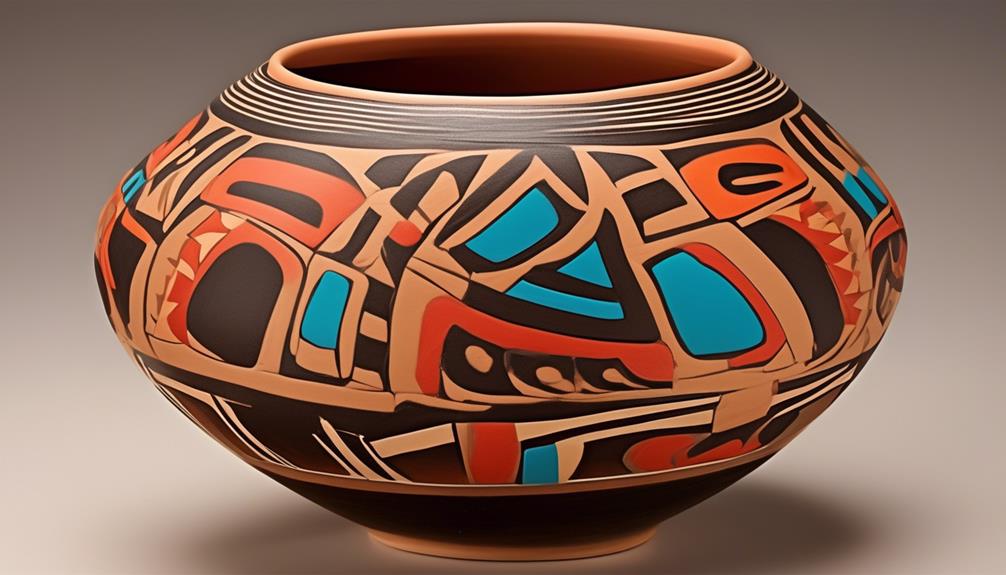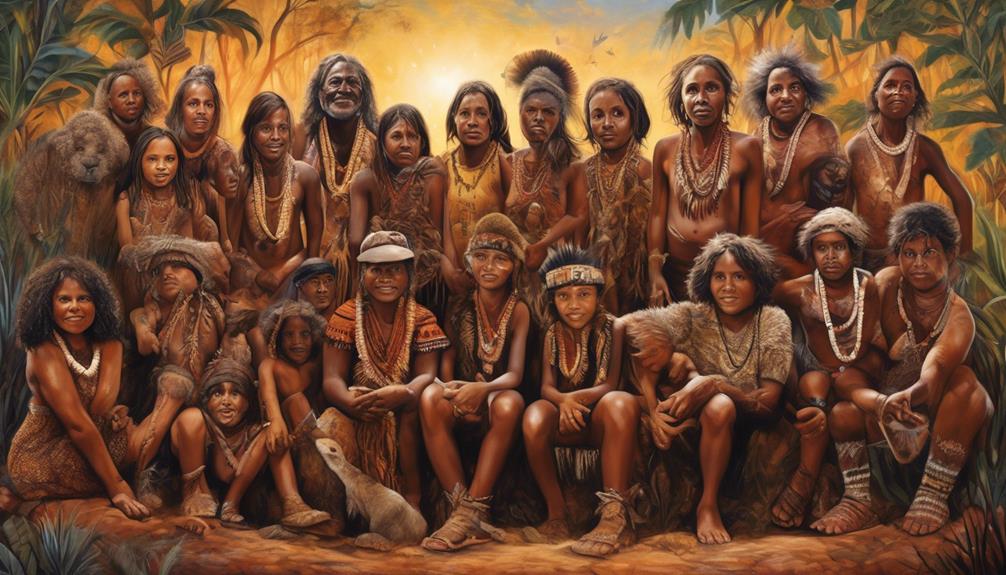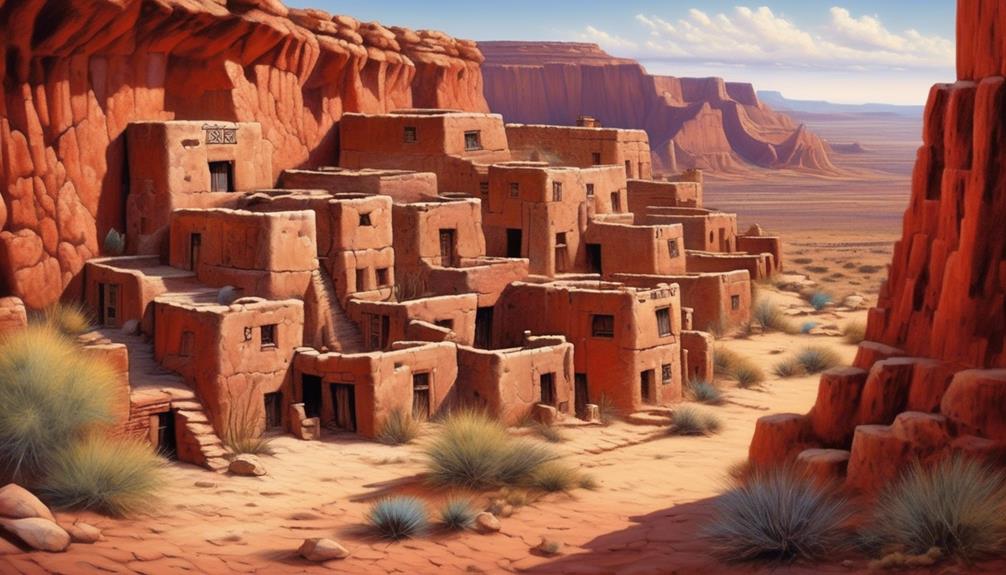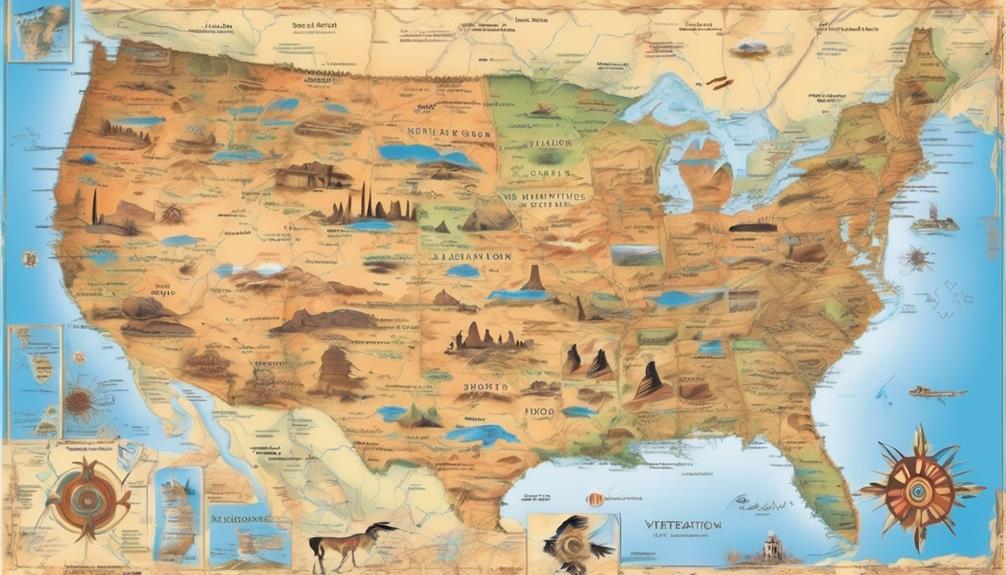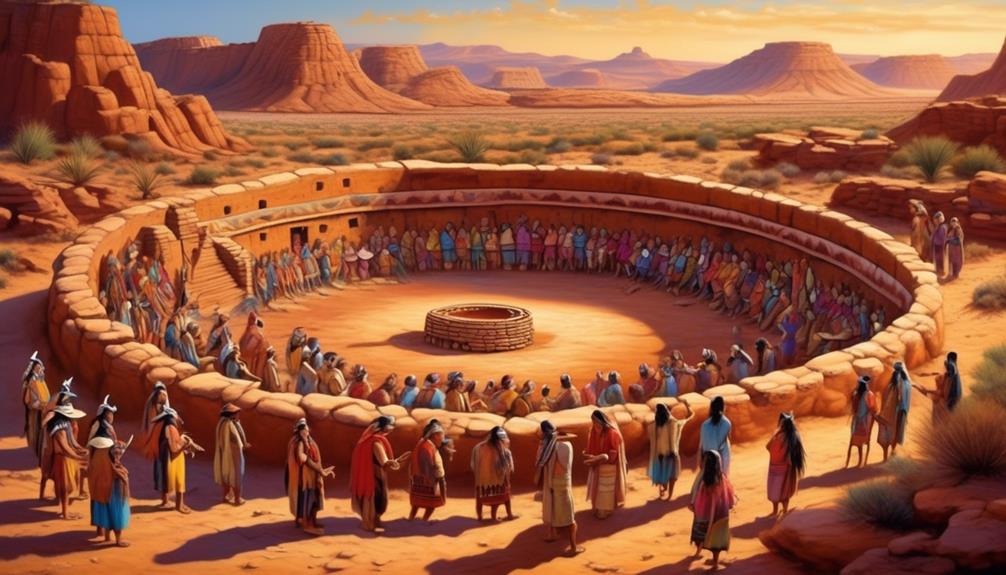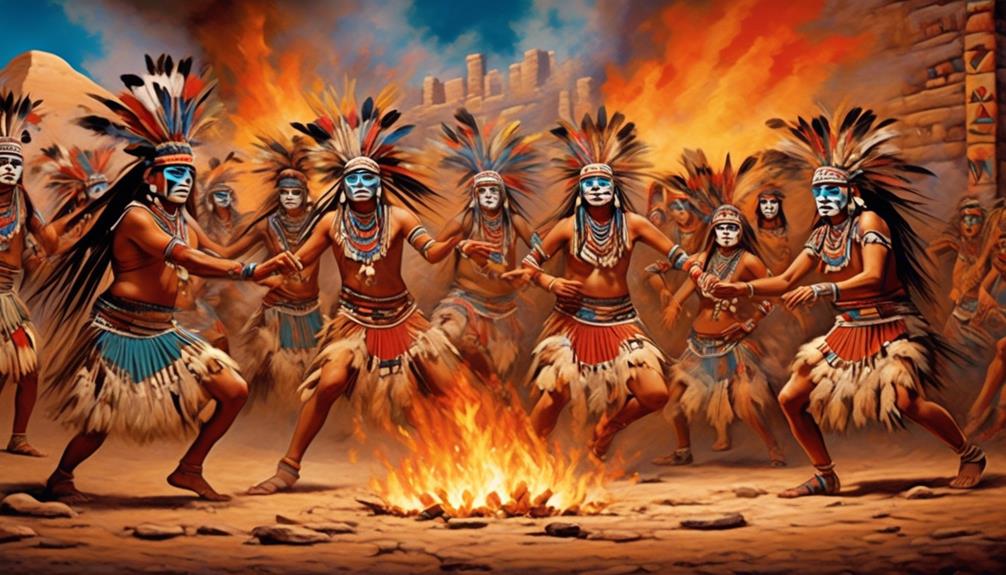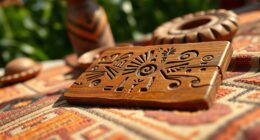When we think about the art of the Hopi tribe, we often picture the intricate designs on their pottery and the colorful feathers adorning their Kachina dolls.
But what if I told you that there's more to Hopi art than meets the eye?
The diverse range of artistic expressions within the Hopi culture offers a fascinating glimpse into their traditions and beliefs, leaving us curious to explore the lesser-known aspects of their creative heritage.
Key Takeaways
- Pottery and ceramic art hold cultural significance for the Hopi Tribe, with traditional techniques and designs being preserved.
- Kachina dolls play a spiritual role as messengers between realms and help preserve Hopi cultural traditions through meticulous craftsmanship.
- Basket weaving showcases profound cultural significance and artistic prowess, with integration of traditional techniques and innovation.
- Textile and weaving art forms incorporate traditional techniques while evolving over time, symbolically representing nature, beliefs, and history.
Pottery and Ceramic Art
What role does pottery and ceramic art play in the cultural heritage of the Hopi Tribe?
Pottery and ceramic art hold immense cultural significance for the Hopi Tribe, reflecting their deep connection to the land and their ancestors. The Hopi techniques used in creating pottery have been passed down through generations, preserving traditional methods and designs. Each piece of pottery tells a story, depicting symbols and motifs that hold spiritual and historical meaning for the Hopi people.
The process of creating pottery is a sacred tradition, often involving the gathering of natural materials from specific locations and the use of unique firing techniques. The intricate designs and patterns found on Hopi pottery are a testament to the tribe's artistic prowess and attention to detail. These pieces serve practical purposes as well, being used in various ceremonies and daily life.
The cultural significance of Hopi pottery extends beyond its aesthetic appeal, serving as a link to the tribe's heritage and traditions. Through the preservation of these artistic practices, the Hopi people continue to uphold their cultural identity and spiritual beliefs. The art of pottery stands as a testament to the resilience and creativity of the Hopi Tribe, showcasing their mastery of traditional techniques and their unwavering commitment to preserving their cultural heritage.
Kachina Dolls

Pottery and ceramic art demonstrate the Hopi Tribe's dedication to preserving cultural traditions, and this commitment is similarly reflected in the craftsmanship and cultural significance of Kachina Dolls. The Kachina Dolls aren't mere playthings; they hold deep spiritual significance and are meticulously crafted with the utmost care and attention to detail. These dolls represent various deities, ancestral spirits, and natural elements that are integral to the Hopi belief system and way of life.
- Spiritual Significance: Kachina Dolls are believed to embody the spirits of deities and ancestors, serving as messengers between the spiritual and earthly realms.
- Craftsmanship: Each Kachina Doll is handcrafted with precision, utilizing traditional techniques that have been passed down through generations, showcasing the skill and artistry of the Hopi people.
- Cultural Preservation: The creation and use of Kachina Dolls play a vital role in preserving and transmitting Hopi cultural traditions, ensuring that their beliefs and practices endure.
- Trade Influence: Kachina Dolls have historically been traded with other Native American tribes, influencing and being influenced by the artistic traditions of neighboring cultures.
- Ritual Use: These dolls are used in various ceremonies and rituals, symbolizing the interconnectedness of the natural and spiritual worlds within the Hopi culture.
Basket Weaving
Basket weaving, an intricate and time-honored craft, holds profound cultural significance for the Hopi Tribe. It serves as a tangible expression of their artistic prowess and connection to the natural world. The art of basket weaving is deeply ingrained in the Hopi cultural heritage, reflecting their intimate relationship with the land and the intricate techniques passed down through generations.
The baskets aren't only utilitarian items but also pieces of art. They are often adorned with symbolic patterns and colors that carry spiritual meanings. The cultural significance of basket weaving extends beyond its practical applications, as it's intertwined with the tribe's traditional ceremonies, storytelling, and everyday life.
The techniques of basket weaving have been meticulously preserved. Modern adaptations carefully balance innovation with the preservation of traditional methods. While contemporary weavers may incorporate new materials and designs, they remain steadfast in upholding the ancestral knowledge and cultural symbolism woven into each creation.
This commitment to preserving the art form ensures that future generations will continue to appreciate the beauty and cultural richness encapsulated in Hopi basketry.
Textile and Weaving
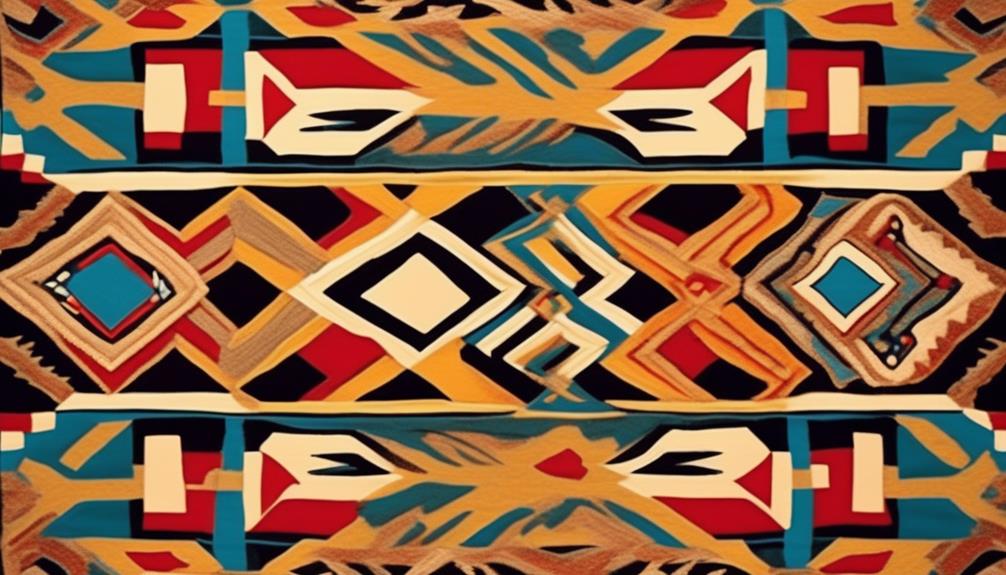
Woven textiles are another integral aspect of the Hopi Tribe's artistic heritage, embodying the same cultural significance and intricate techniques as their renowned basket weaving traditions. The Hopi people have a rich tradition of creating textiles using traditional techniques that have been passed down through generations. These textiles often feature symbolic designs and patterns that hold deep cultural meaning, reflecting the tribe's connection to their land and spiritual beliefs. The art of weaving isn't just a craft, but a form of storytelling and cultural expression for the Hopi Tribe.
- Traditional Techniques: The Hopi people employ traditional methods of spinning and dyeing wool, as well as using a backstrap loom for weaving, preserving the ancient techniques of their ancestors.
- Cultural Significance: Textiles play a crucial role in Hopi ceremonies and rituals, with specific designs and colors holding spiritual and ceremonial importance.
- Modern Influences: While traditional techniques are preserved, modern influences have also led to artistic evolution, with weavers incorporating contemporary elements into their designs.
- Artistic Evolution: The art of weaving among the Hopi Tribe has evolved over time, adapting to changing influences while maintaining its cultural authenticity.
- Symbolism and Meaning: Each woven textile carries deep symbolic significance, often representing elements of nature, spiritual beliefs, and the tribe's history.
Jewelry and Silversmithing
Jewelry and silversmithing hold a revered place within the artistic traditions of the Hopi Tribe, reflecting the intricate craftsmanship and cultural significance deeply rooted in their heritage. The Hopi artisans are renowned for their exquisite turquoise jewelry, which is a testament to their exceptional skills and deep spiritual connection to the earth. The use of turquoise in their jewelry not only showcases the stunning beauty of this gemstone but also holds great symbolic importance within the Hopi culture, representing life, health, and prosperity.
The creation of turquoise jewelry among the Hopi involves a delicate and detailed process, utilizing traditional techniques that have been passed down through generations. Each piece is meticulously crafted, with the artisans paying close attention to every intricate detail. The combination of sterling silver and turquoise in their jewelry reflects the harmonious relationship between the natural and the human-made, embodying the Hopi belief in balance and interconnectedness with the natural world.
Furthermore, the jewelry often features intricate designs that hold deep cultural significance, depicting symbols and motifs that convey stories of the Hopi people, their traditions, and their spiritual beliefs. The artistry and cultural richness embodied in Hopi jewelry make it an integral part of their heritage and a true reflection of their artistic mastery.
Frequently Asked Questions
What Role Did Music and Dance Play in Hopi Art and Culture?
Music, dance, and rituals were integral to Hopi culture. They played a central role in ceremonies, connecting us to our ancestors and spiritual traditions.
The rhythmic beats and movements in dance expressed our beliefs and stories. Music accompanied ceremonies, creating a powerful, immersive experience.
These artistic expressions weren't just performances, but essential elements of our cultural identity, reinforcing our values and strengthening our community bonds.
How Did the Hopi Tribe Use Natural Materials in Their Artwork?
Using natural materials, the Hopi tribe employed various artistic techniques to create intricate and meaningful artwork. They skillfully fashioned pottery, baskets, and textiles from materials like clay, reeds, and cotton.
The tribe's reverence for nature was evident in their artwork, with designs often inspired by flora and fauna. The intricate weaving and pottery techniques showcased the tribe's mastery of their craft, highlighting the deep cultural significance of their artwork.
What Is the Significance of Mural Art in Hopi Culture?
Mural art holds immense significance in Hopi culture, serving as a powerful medium for storytelling and preserving traditions. Its symbolism reflects the tribe's deep connection to nature and spirituality.
Techniques like natural pigments and intricate brushwork bring these murals to life, while materials such as clay and sand convey ancestral ties. Through these murals, the Hopi people express their history, values, and spiritual beliefs, fostering a profound cultural legacy.
Did the Hopi Tribe Create Any Forms of Sculpture or Carving?
Yes, the Hopi tribe created various forms of sculpture and carving as part of their artistic expression. These traditional artifacts often depict religious and ceremonial themes, showcasing the tribe's intricate artistic techniques and cultural significance.
Sculptures and carvings are an integral part of the Hopi tribe's artistic legacy, representing their deep connection to spirituality and their commitment to preserving their cultural heritage through visual storytelling.
How Did the Hopi Tribe Incorporate Storytelling Into Their Artistic Traditions?
Weaving together storytelling and visual arts, the Hopi tribe showcases their rich cultural heritage. Through pottery, katsina dolls, and intricate murals, they convey myths, legends, and historical events, grounding their art in tradition and spirituality.
The intricate patterns and symbols in their artwork serve as visual narratives, passing down wisdom and preserving their collective memory.
The fusion of storytelling and artistic expression allows the Hopi tribe to celebrate their identity and traditions.
Conclusion
In conclusion, the art of the Hopi tribe reflects their deep connection to their culture and spirituality.
From their intricate pottery and kachina dolls to their beautiful basket weaving and jewelry, each piece tells a story of tradition and identity.
Through their art, the Hopi people preserve their heritage and pass down their rich history to future generations, reminding us of the importance of honoring our roots and preserving our cultural heritage.
Mary is a passionate writer who brings creativity and a fresh perspective to our team. Her words have the power to captivate and inspire, making her an essential contributor to our content. Mary’s commitment to storytelling and dedication to promoting Indigenous culture ensures that her work touches the hearts of our readers. We’re fortunate to have her as part of our team.
